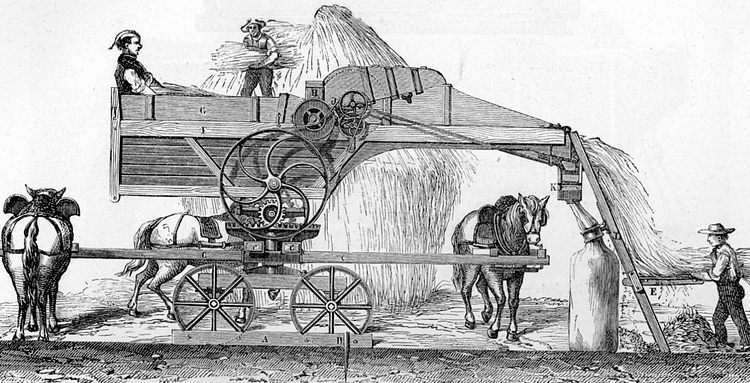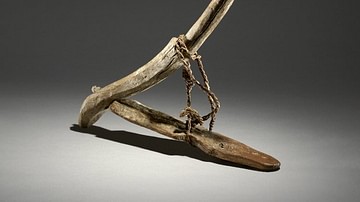Agriculture, like most other areas of working life, was greatly affected by the machines invented during the Industrial Revolution. Agriculture in Britain and elsewhere had made leaps forward in the 18th century, and its success released labour for factories in urban areas. From better iron tools to threshing machines, country life was transformed in the never-ceasing search for profit.
Uses of Steam Power in Agriculture
In the 18th century, agricultural activities across the world continued to use people power and animal muscles to make work easier and more efficient. In Europe, and particularly in Britain, the relatively high cost of labour (compared to, for example, Asia), drove inventors to create machines that would make farming cheaper and profits higher by replacing where possible traditional sources of power with machines.
A change to a fundamental farming method came with Andrew Rodger's invention of the winnowing machine in Scotland in 1737. For millennia wheat had been separated from chaff by simply throwing the two into the wind and allowing the chaff to blow away. The method was effective enough, but the wind had to be not too weak and not too strong, and those days without wind at all were useless. Rodger's machine worked using an internal fan, and it was capable of separating out the grain, chaff, dust, and straw. The fan was operated by hand, but the machine was another one of those that benefitted from adding a mechanism that used steam power.
The first steam engines to be used in agriculture were those attached to mills. Waterwheels had long been in use to move grinding stones to produce flour, but steam engines could now be used as a backup for when the water level of the river powering the waterwheel was low. Windmills had also been around a long time, but better ironwork during the Industrial Revolution meant that pieces like the sails' turning mechanism, brakes, and the fantail (which made sure the sails pointed in the direction of the wind) were better made and more efficient than ever before. From the 1860s, a new method of grinding flour, the roller mill, gradually began to replace windmills after its introduction to Britain from central Europe.
By the last quarter of the 18th century, engineers had perfected the steam engine so that it was mobile and fuel-efficient enough to be used anywhere. This mobility of power was particularly useful for agriculture. In 1787, the Scotsman Andrew Meikle (1719-1811) invented the first steam-powered threshing machine (which separates grain from the husk). The machine used a drum with beaters to remove the husk, first using horse or water power and then steam power. It greatly increased the speed at which grain could be threshed. The invention was successful at home and abroad; George Washington (1732-1799) ordered a Meikle threshing machine for his own farm. Another feature of mechanization in the Americas was the introduction of machines on plantations, used, for example, to crush sugar cane. In 1834 in the United States, Cyrus McCormack invented the first mechanized reaping machine. Now a farmer need only hire a machine for when he actually needed it, perhaps only a few weeks in the year.
Mobile steam engines were used to pump out waterlogged areas to make them useful for agriculture – a single machine was capable of draining 24 km² (6000 acres). Drainage trenches were cut using machines, and then pipes were laid down to better drain fields. These works meant areas of common land could be claimed for agricultural use, a process known as enclosure. As technology developed, powerful steam engines could be brought almost anywhere on a farm to uproot trees and hedges to make fields easier and more efficient to plough. Steam power was harnessed, too, for many other tasks such as cutting lumber.
Better Tools & Equipment
Agriculture continued to be a major sector of employment even after the Industrial Revolution swept through Britain. In 1841, "just over 1 in 5, 22 percent of the country's workforce, worked on the land" (Shelley, 44). Even if many of these agricultural jobs still involved working by hand, the tools used were often made by precision machines powered by steam. A long-bladed scythe was found to be much more efficient than the traditional sickle. Horse-drawn ploughs now had more efficient iron blades, seed drills had more hard-wearing parts, and cutting tools had a finer and more durable cutting edge.
The Rotherham swing plough was invented by Joseph Foljambe in Yorkshire in 1730. This new type of plough was made from cast iron and could better follow the contours of the land. Foljambe's plough became so popular he was soon mass-producing them in a factory near Rotherham. As with other mass-produced tools during the Industrial Revolution, Foljambe ensured that the various parts of his plough could be easily replaced with new parts when broken or worn out. Mass-produced and with a longer life of use, such tools were now more affordable to more farmers.

The science branch of the Industrial Revolution also made great leaps forward possible for agriculturalists. Scientists took a great interest in farming and how to improve it, which led to the formation of the Royal Agricultural Society in 1842. Joseph Henry Gilbert and John Bennet Lawes extensively tested soil types and plants in their Rothamstead Agricultural Laboratory. The results of these experiments allowed the laboratory to produce much more effective fertilizers, significantly improving crop yields from the 1860s.
Consequences
Mechanization in agriculture reduced labour costs and so the cost, too, of foodstuffs; people ate more and better food with a direct consequence on life expectancy, particularly of children. As farming became more profitable, there were more and more cases of enclosure as people searched for more wealth. Sometimes land was claimed in this way against the wishes of the local people, since, by law, consent of 80% of the population was required, but that might be met if a single large landowner acquiesced to the enclosure. In 55 years from 1760 to 1815, over 28,300 km² (7 million acres) of British communal land was enclosed. Further, as land was made better for farming thanks to drainage projects, rents rocketed, which meant many small-scale farmers were forced to move elsewhere or try a different profession.
A knock-on effect of industrialization was caused by the great technological developments in transport, especially the railways and steamships. As transport networks became wider, denser, and cheaper, so the goods which were transported became cheaper. Less expensive grains came to Britain from the United States and Canada. This was a much-needed development since, despite the improvement in agricultural yields at home, they could not meet the appetite of a booming population. A second technological innovation with far-reaching consequences was the invention of refrigerated transport, which meant that meat could be shipped to Britain from as far afield as Argentina, Australia, and New Zealand. Produced on vast farmlands in these countries, the imported meat was cheaper than British-grown meat. By the 1780s, Britain had moved from being a net exporter of foodstuffs to a net importer, and the deficit kept on growing into the next century. Cheaper goods was one of the contributing factors to the Great Depression in agriculture in 1873.

The 1851 census in Britain revealed that, for the first time, more people were living in towns and cities than in the countryside. The rise of mechanized factories in the bigger cities, particularly in the textile industry, lured many agricultural workers to a better and more stable living in urban areas. These labourers were given a further incentive to move homes by the increased mechanization of farming and the consequent decrease in jobs. The success of agriculture, what some have termed the Agricultural Revolution that preceded and overlapped the Industrial Revolution, meant that it could withstand this loss of labour. Indeed, some historians have argued that only because agriculture was so efficient in Britain could the Industrial Revolution have taken place. This point that British agriculture helped the industrialization of Britain to begin earlier than elsewhere is summarised by J. Horn:
Agriculture represented an enormous and continuing comparative advantage. At the dawn of the industrial age, the output per worker of British agriculture was one-third greater than France's and twice that of Russia, while Europe enjoyed double the productivity of any other part of the world. By 1851, British output per worker was twice that of any contemporary European state. Not only did high agriculture productivity foster effective work habits throughout the population, but it also released labour.
(68)
As in other areas of the economy in the Industrial Revolution where one area of working life boosted another, the success of agriculture allowed for the growth in mechanized factories in urban areas, which caused a growth in population which, in turn, created a greater market for agricultural products, further boosting the farming industry. The historian R. C. Allens argues that it was the latter relationship which was more important, "The city drove the countryside – not the reverse" (58). Although Allen also recognizes that greater efficiency in agriculture was essential to help feed the growing cities: "By 1800 each English farm worker produced enough to support two workers in manufacturing and services" (ibid).
There were some who fought back against the changes in British country life. Just like the Luddites, the handweavers who smashed textile machines that took away their livelihood in cities, so, too, farm labourers attacked, for example, the new threshing machines. One period of wrecking was particularly intense and became known as the Swing Riots (after their legendary leader Captain Swing) of 1830 to 1832. The Swing Rioters might have won the public's sympathy, but the government was determined on 'progress' so that hundreds were imprisoned, transported, or hanged while the pitiless machines kept on turning regardless in the fields, just as they did in the factories.







